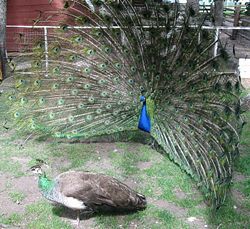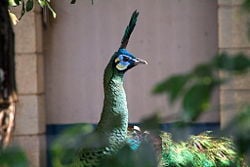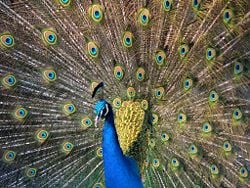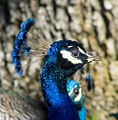Peafowl
{{#invoke:Message box|ambox}}
- "Peacock" redirects here.
| Peafowl | ||||||||||||
|---|---|---|---|---|---|---|---|---|---|---|---|---|
 An Indian Blue Peacock (rear) courts a peahen (front)
| ||||||||||||
| Scientific classification | ||||||||||||
| ||||||||||||
|
'Pavo antiquus |
The term peafowl can refer to the two species of bird in the genus Pavo of the pheasant family, Phasianidae. The African Congo Peafowl is placed in its own genus Afropavo and is not dealt with here. Peafowl are best known for the male's extravagant tail, which it displays as part of courtship. The male is called a peacock, the female a peahen[1], though it is common to hear the female also referred to as a "peacock" or "female peacock." The female peafowl is brown or toned grey and brown.
The two species are:
- Indian Peafowl, Pavo cristatus (Asiatic)
- Green Peafowl, Pavo muticus (Asiatic)
The Indian Peafowl is a resident breeder in the Indian subcontinent. The peacock is designated as the national bird of India.
The Green Peafowl breeds from Burma east to Java. The IUCN lists the Green Peafowl as vulnerable to extinction due to hunting and a reduction in extent and quality of habitat.
Taxonomy
The Indian Peafowl is monotypic, while the Green Peafowl has 3 subspecies, P. muticus spicifer, P. m. imperator and the nominate P. m. muticus.[2] The two species are largely allopatric but will hybridize in captivity.
While the form of Green Peafowl in Yunnan is not separated taxonomically, it differs in a few aspects from other forms, particularly in its forest-dwelling habits, an "odd, monal-like bill," a curiously long hind toe and longer, more slender wings (K. B. Woods in litt. 2000) [3]. Some have suggested this is a new subspecies.
Some pheasant breeders have suggested that the Green Peafowl may have more subspecies.[4][5]
Peafowl have sometimes been included in a distinct family from Pheasants [6].
Plumage
The male (peacock) Indian Peafowl has iridescent blue-green or green coloured plumage. The so-called "tail" of the peacock, also termed the "train," is not the tail quill feathers but highly elongated upper tail coverts. The train feathers have a series of eyes that are best seen when the train is fanned. The actual tail feathers are short and gray-colored and can be seen from behind when a peacock's train is fanned in a courtship display. During the molting season, the males shed their stunning train feathers and reveal the unassuming gray-colored tail which is normally hidden from view beneath the train. Both species have a crest atop the head.
The female (peahen) Indian Peafowl has a mixture of dull green, brown, and grey in her plumage. She lacks the long upper tail coverts of the male but has a crest. The female can also display her plumage to ward off female competition or danger to her young.
The Green Peafowl is very different in appearance to the Indian Peafowl. The male has green and gold plumage and has an erect crest. The wings are black with a sheen of blue.
Unlike the Indian Peafowl, the Green Peahen is very similar to the male, only having shorter upper tail coverts and slightly less iridescent in some regions. Like other peafowl, it is very difficult to distinguish a juvenile male from an adult female. Moreover, the sexes of the various Green Peafowl species are almost impossible to tell apart in the field during the months when the male has no train.
Many of the brilliant colours of the peacock plumage are due to an optical interference phenomenon (Bragg reflection) based on (nearly) periodic nanostructures found in the barbules (fiber-like components) of the feathers.
Different colours correspond to different length scales of the periodic structures. For brown feathers, a mixture of red and blue is required: one colour is created by the periodic structure, and the other is a created by a Fabry-Perot interference peak from reflections off the outermost and innermost boundaries of the periodic structure.[citation needed]
Such interference-based structural colour is especially important in producing the peacock's iridescent hues (which shimmer and change with viewing angle), since interference effects depend upon the angle of light, unlike chemical pigments.
Behaviour
The peafowl are forest birds that nest on the ground. The Pavo peafowl are terrestrial feeders but roost in trees.
Both species of Peafowl are believed to be polygamous. However, it has been suggested that "females" entering a male Green Peafowl's territory [7] are really his own juvenile or subadult young (K. B. Woods in litt. 2000) and that Green Peafowl are really monogamous in the wild. The male peacock flares out its feathers when it is trying to get the females attention. Those who subscribe to this notion cite the similarities between the sexes.
During mating season they will often emit a very loud high pitched cry.
Diet
Peafowl are omnivorous and eat ticks, termites, ants,locusts, mice, plant parts, flower petals, seed heads, scorpions and other arthropods, reptiles, and amphibians.
In common with other members of the Galliformes, males of most species and females of all but two species, possess powerful, wickedly sharp, metatarsal spurs or "kicking thorns" used primarily to protect themselves against predators and to a lesser extent during intraspecific fights.
Habitat
Asiatic peafowl like the Indian Blue Peafowl, and especially the Green Peafowl, occupy a similar niche as the roadrunners, Secretary Bird, and seriemas. All of these birds hunt for small animals including arthropods on the ground and tall grass and minnows in shallow streams.
Because of human encroachment into their natural territories, peafowl and humans have come into increasing contact. Because of their natural beauty some are reluctant to classify the birds as pests but their presence can be disturbing, especially given their tendency to eat indiscriminately of garden boundaries and the male's powerful vocal crow (louder than a rooster's crow).
Feral populations
Peafowl have left captivity and developed permanent, free-roaming populations in several parts of the world including Coconut Grove, Miami, Florida and Arcadia, California.
Gallery
Indian Peafowl
- 040411.JPG
Closeup of an Indian Blue Peacock's head
- Dscn08507wr.jpg
The Black-Shouldered Peacock was once thought to be a distinct subspecies, but is now considered a color mutation
- White peacock.jpg
A white peacock showing off his plumage
- 178279581 2b22d77351.jpg
Male Indian Blue Peacock at Grounds for Sculpture in Hamilton Township, New Jersey
- Peacock-rtisbute-steven-viemeister-1.jpg
A white peacock domesticated in Mexico.
Peacock seen in San Francisco, California
Green Peafowl
- Frankyboy Pavo muticus.JPG
Pavo muticus muticus
ReferencesISBN links support NWE through referral fees
- ↑ peacock - Britannica Online Encyclopedia
- ↑ Madge, S. and P. McGowan (2002) Pheasants, Partridges and Grouse ISBN 0-7136-3966-0
- ↑ [1]
- ↑ Pfauenzucht Mennig
- ↑ PDF in German
- ↑ WPA - Deutschland
- ↑ Gallery :: SOUTHERN spicifer{Irrawady basin and southern Burma to the Salween drainage basin. This is the nominate form Pavo spicifer spicifer :: 19
- Kimball, Rebecca T., Edward L. Braun, and J. David Ligon (1997). Resolution of the Phylogenetic Position of the Congo Peafowl, Afropavo congensis: A Biogeographic and Evolutionary Enigma. Proceedings: Biological Sciences, vol. 264 (1387), pp. 1517-1523
- van Balen, S., Prawiradilaga, D. M. and Indrawan, M. (1995) The distribution and status of Green Peafowl in Java. Biol. Conserv. 71: 289-297.
External links
- Zoonomen - Zoological Nomenclature Resource — World Birds Taxonomic List as of 2006-09-26
- Peafowl Varieties Database
- The Peacock Pages: All About Peacocks!, An article by Lisa Johnson from the Game Bird and Conservationists' Gazette — Aspects of the cultural role of peafowl and their place in aviculture.
- United Peafowl Association Knowledge Base
- "Behavioural Ecologists Elucidated How Peahens Choose Their Mates, And Why", an article at ScienceDaily.com
- Peafowl videos on the Internet Bird Collection
- Peacock — Etymology of the word
- Video of a peacock showing of his plumage
Credits
New World Encyclopedia writers and editors rewrote and completed the Wikipedia article in accordance with New World Encyclopedia standards. This article abides by terms of the Creative Commons CC-by-sa 3.0 License (CC-by-sa), which may be used and disseminated with proper attribution. Credit is due under the terms of this license that can reference both the New World Encyclopedia contributors and the selfless volunteer contributors of the Wikimedia Foundation. To cite this article click here for a list of acceptable citing formats.The history of earlier contributions by wikipedians is accessible to researchers here:
The history of this article since it was imported to New World Encyclopedia:
Note: Some restrictions may apply to use of individual images which are separately licensed.
















